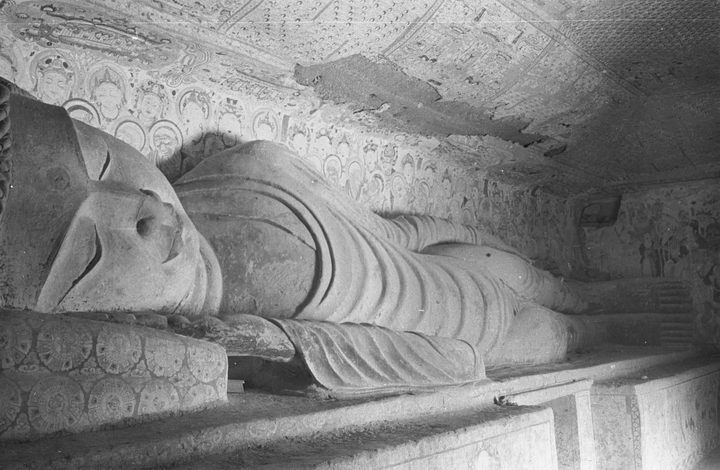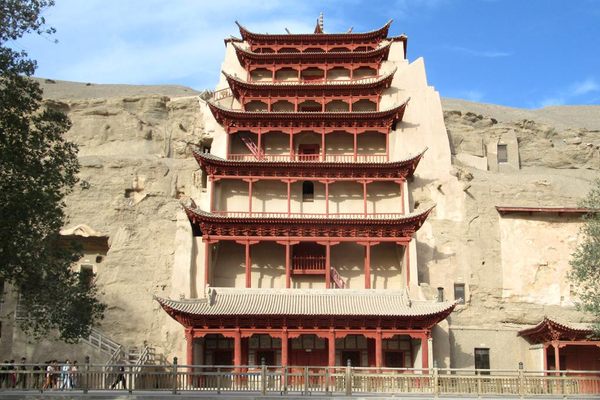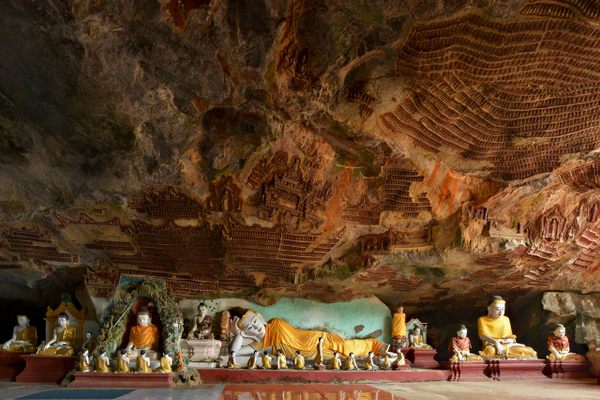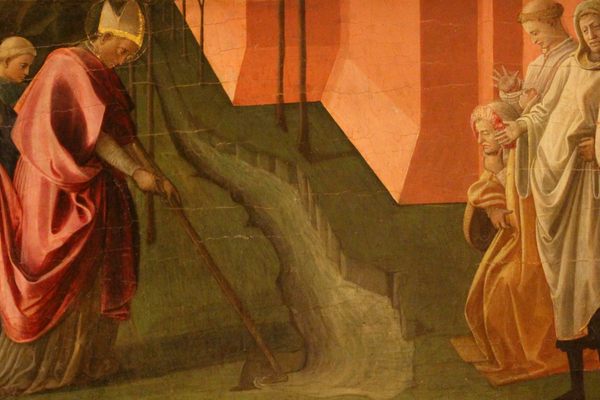
The Adventurous Quest to Capture Remote Buddhist Caves in the 1940s
Innovative photographers James and Lucy Lo created a time capsule of a sacred space at a vulnerable time.
In the spring of 1943, during the Sino-Japanese War, photographer James Lo and his wife Lucy Lo ventured to a set of remote, nearly abandoned caves near where the ancient northern and southern Silk Road trade routes converged, at the nexus of China and Central Asia. There were 700 carved spaces in the face of a cliff, known as the Mogao Caves. Among them, some 500 were profusely decorated with sculptures and murals, remarkable examples of Buddhist art that span 1,000 years. Today, the caves’ 2,000 painted sculptures and nearly 485,000 square feet of wall paintings are preserved as a UNESCO World Heritage Site, popular with tourists. But back in 1943, when the Los encountered them, they were deteriorating and neglected. Over the next year or so, the Los systematically photographed the Mogao Caves, as well as the nearby Yulin Caves; the 3,000 black-and-white images are a significant document of these incredible and vulnerable sacred spaces. Many of images of this archive are going to be presented for the first time in print in an upcoming nine volume set, Visualizing Dunhuang: Seeing, Studying, and Conserving the Caves, edited by Dora C.Y. Ching and published by Princeton University Press.
The Los were resourceful in the face of challenging conditions. For light, James Lo carefully placed mirrors and white cloth screens to bring illumination into the dim, dark caves. To conserve film, he sometimes shot two different images on a single sheet of the negative for his large, 6x8 field camera. (He also used a 4x5 Speed Graflex and a 35 mm Leica.) For an on-site darkroom, he brought water from a nearby mountain stream with bamboo piping. The resulting images are not only sharply focused and well-exposed, but also artistically composed. “They made what amounts to a photographic time capsule of the caves as they were in the 1940s, before restoration and conservation permanently changed the cliff face,” writes Ching. “This work was absolutely necessary, but the now vanished views are preserved in the Lo photographs.”

Atlas Obscura emailed with Ching, the associate director of the P.Y. and Kinmay W. Tang Center for East Asian Art at Princeton University to learn more about what life in the Mogao Caves might have been like, other creative things the Los accomplished there, and what it is like to visit the caves in person.
Can you describe what religious life at the Mogao Caves would have been like during the height of its development and use?
[The nearby town of] Dunhuang long served as a gateway between China and Central Asia. Toward the west, trade routes extended to Kashgar and the Pamirs, and then to Central Asia and Persia. Toward the east, routes led to the ancient capital Chang’an (present-day Xi’an) in China. To the north was the Russian Steppe, and to the south lay India. Because of its position in this network of land routes, Dunhuang became the seat of government for local polities and a major hub, attracting traders, Buddhist pilgrims, and visitors of all sorts. In short, it was a vibrant commercial, political, and artistic center.
Just 25 kilometers [15 miles] southeast of Dunhuang, a cliff along the Daquan River proved to be the perfect location for making cave temples, now called the Mogao Caves. Over the course of 1,000 years, architects, craftsmen, painters, and sculptors built and decorated nearly 500 caves, while an additional 200-plus caves were made as living or burial chambers. The land across the river from the caves. which one traverses to access the site today, served as a cemetery. During the height of activity, the site would have supported a community of builders and artisans to construct and decorate new caves, and monks would have been living at the caves. A number of clans had family caves that they maintained across generations, and dedication ceremonies and other religious gatherings were most likely conducted from time to time. If one looks at some of the murals, one can imagine what life might have been like: caravans of merchants and adventurers and their camels traveling through the landscape and arriving at and departing from towns, as well as Buddhist laypeople performing rituals.

How did the caves come to be almost entirely forgotten? And how did they ultimately survive?
Activity at the cave sites near Dunhuang spanned about 1,000 years, when successive polities ruled over the region. By the 15th century, although official imperial Chinese embassies traveled from the Ming capital in Beijing to Tibet, more travel and trade took place along the sea routes, while the overland routes were less traveled. Without a constant stream of travelers and a stable population, construction and maintenance of the Buddhist caves could no longer be supported. Locals always knew about the caves, but because of the remoteness, the caves were virtually forgotten.
To a certain extent, the climate and the relative inaccessibility of the sites protected and preserved the caves. However, the caves did deteriorate because of the harshness of the environment. The front facade of the caves, as well as many wooden structures, in the cases where some were built at the entrances of caves, collapsed. When this happened, shallow caves were especially vulnerable to damage from light and sand abrasion. Periodic flooding of the Daquan River caused water damage in the lowest tier of the caves.
The Lo Archive photographs show the state of the cave site in the 1940s, when most of the cave fronts had fallen away and the murals and sculptures were exposed to the elements.

This project must have been especially difficult for James and Lucy Lo in 1943 and 1944, which you describe in the book as “a particularly volatile cultural moment”?
I am still astonished by the Los’ self-directed photographic expedition. They mounted their expedition during the Sino-Japanese War, setting off from Chongqing, Sichuan Province, which had been bombed repeatedly by the Japanese. For the Central News Agency, James Lo had photographed the destruction caused by bombing runs. The Los were not on the periphery, but in the midst of a dangerous situation. Their home in Chongqing bore the scars of bombing runs; the foundation and walls had so badly cracked that one of their friends, a famous architect, refused to stay with them when visiting. Prior to embarking on their journey to Dunhuang, they had to plan what supplies they would need and procure all of it—again, no small feat during a war. They also faced many unknowns, such as how they were going to arrange for transportation, what would they find in Dunhuang. Did they prepare enough film stock and chemicals, how were they going to live?
Once they arrived at the caves, they faced the challenges of the project. They had to plan what of the 1.6-kilometer [1 mile] stretch of the cliff to photograph—exteriors, interiors, details, etc.—and meter out the film carefully. The condition of the cliff and cave temples ranged from total darkness inside to collapsed fronts and floors. Some caves were simply inaccessible; others were accessible but in danger from crumbling walls or floors. They had no electricity and no running water, and they had to figure out where to live and how to take care of daily necessities, such as food.
The fact that they produced such a large, valuable collection of photographs is a testament to their vision, fortitude, and ingenuity.

From your interviews with Lucy Lo, were there any interesting details you can share?
Three stories come to mind, each highlighting a particular trait that I think helped the Los be successful in their grand photographic endeavor.
First, in order to develop the negatives, James Lo needed a water tank, so he made one out of ceramic sherds he collected from the site. This is but one example of his inventiveness.
Second, to celebrate National Day on October 10, 1943, the Los hosted a tea party at the caves for visitors who happened to be there, including British sinologist and historian of science Joseph Needham and New Zealand–born political activist Rewi Alley. They cooked up a feast and shared everything they had, demonstrating their graciousness.
Third, in what I interpret as joie de vivre, James Lo quietly made ice cream out of goat milk, some sugar, and some flavoring by mixing everything together in an enameled bowl and placing it outside on a cold stone overnight—mixing it from time to time—and surprising Lucy the next morning.

You have studied the caves firsthand. What was most fascinating and memorable to you?
The site is magical: Hundreds of caves, large and small, are filled with vibrantly colored murals and sculptures. Before the first time I visited Dunhuang in 1993 and 1994, I had seen photographs, but nothing prepared me for experiencing the caves. Walking into a dark, cool cave—no matter how hot it was outside—and viewing the cave by flashlight transported me to a different time, where I was immersed, completely surrounded, by Buddhist murals and sculptures. It felt like I had entered a different realm.
An art historian at heart, I marveled at the sheer magnitude, beauty, and exquisite skill of the painters and sculptors—and how I could witness in one site the arc of 1,000 years of artistic and doctrinal styles.

































Follow us on Twitter to get the latest on the world's hidden wonders.
Like us on Facebook to get the latest on the world's hidden wonders.
Follow us on Twitter Like us on Facebook